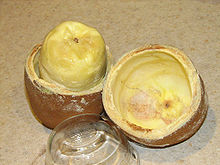Cupuaçu
| Cupuaçu | |
|---|---|
 |
|
| Scientific classification | |
| Kingdom: | Plantae |
| (unranked): | Angiosperms |
| (unranked): | Eudicots |
| (unranked): | Rosids |
| Order: | Malvales |
| Family: | Malvaceae |
| Genus: | Theobroma |
| Species: | T. grandiflorum |
| Binomial name | |
|
Theobroma grandiflorum (Willd. ex Spreng.) K.Schum. |
|
Cupuaçu (Theobroma grandiflorum), also spelled cupuassu, cupuazú, cupu assu, and copoasu, is a tropical rainforest tree related to cacao. Common throughout the Amazon basin, it is widely cultivated in the jungles of Colombia, Bolivia and Peru and in the north of Brazil, with the largest production in Pará, followed by Amazonas, Rondônia and Acre.
Cupuaçu trees usually range from 5–15 m (16–49 ft) in height, though some can reach 20 m (66 ft). They have brown bark and leaves are 25–35 cm (9.8–13.8 in) long and 6–10 cm (2.4–3.9 in) across, with 9 or 10 pairs of veins. As they mature, the leaves change from pink-tinted to green, and eventually they begin bearing fruit. Cupuaçu fruits are oblong, brown, and fuzzy, 20 cm (7.9 in) long, 1–2 kg (2.2–4.4 lb) in weight, and covered with a thick 4–7 mm (0.16–0.28 in), hard exocarp.
The white pulp of the cupuaçu has an odour described as a mix of chocolate and pineapple and is frequently used in desserts, juices and sweets. The juice tastes primarily like a pear, with a hint of banana.
Cupuaçu flavors derive from its , such as tannins, glycosides, theograndins, catechins, quercetin, kaempferol and isoscutellarein.
It also contains caffeine, theobromine, and theophylline as found in cacao, although with much lower content of caffeine.
...
Wikipedia
